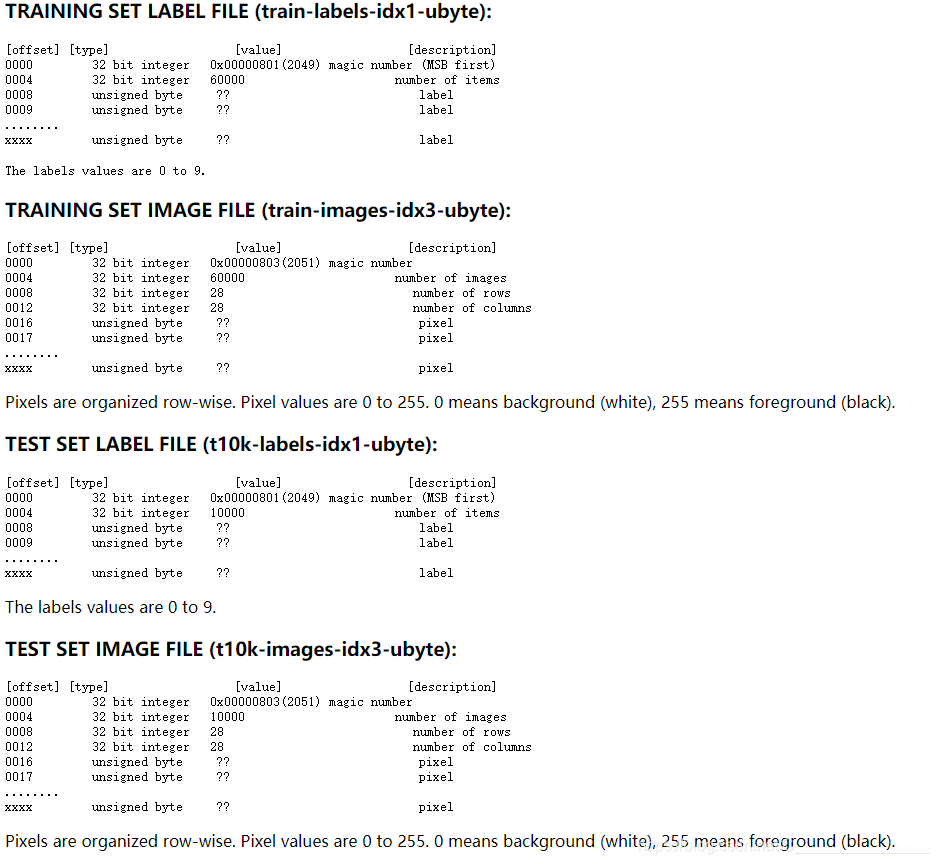C++基于文件流与armadillo读取mnist示例详解
作者:c艹用户
这篇文章主要给大家介绍了关于C++基于文件流与armadillo读取mnist的相关资料,文中通过示例代码介绍的非常详细,对大家的学习或者工作具有一定的参考学习价值,需要的朋友们下面随着小编来一起学习学习吧
前言
发现网上大把都是用python读取mnist的,用C++大都是用opencv读取的,但我不怎么用opencv,因此自己摸索了个使用文件流读取mnist的方法,armadillo仅作为储存矩阵的一种方式。
1. mnist文件
首先避坑,这些文件要解压。

官网截图可知,文件头很简单,只有若干个32位整数,MSB,像素和标签均是无符号字节(即unsigned char)可以先读取文件头,再读取剩下的部分。
2. 读取文件头
我觉得没什么必要啊,直接跳过不行吗
文件头都是32位,那就整四个unsigned char呗。
uchar a, b, c, d; File >> a >> b >> c >> d;
这样a、b、c、d就保存了一个整数。
x = ((((a * 256) + b) * 256) + c) * 256 + d;
然后就得到了呗。
看每个文件有多少文件头,就操作几次(并可以顺便与官方的magic number进行对比),剩下的就是文件的内容了。
3. 读取内容
这部分可以依照之前的方法,一次读取一个字符,再保存至矩阵当中。例如:
uchar a;
mat image(28, 28, fill::zeros); // 这是个矩阵!
for(int i = 0; i < 28; i++) //28行28列的图像懒得改了
for(int j = 0; j < 28; j++)
{
File >> a;
image(i, j) = double(a);
}
这样就读取了一张图片。其余以此类推吧。
4. 完整代码
可以复制,可以修改,也可以用于商用和学术,但是请标注原作者(就是我)。
mnist.h
#ifndef MNIST_H #define MNIST_H #include<iostream> #include<fstream> #include<armadillo> #define uchar unsigned char using namespace std; using namespace arma; //小端存储转换 int reverseInt(uchar a, uchar b, uchar c, uchar d); //读取image数据集信息 mat read_mnist_image(const string fileName); //读取label数据集信息 mat read_mnist_label(const string fileName); #endif
mnist.cpp
//mnist.cpp
//作者:C艹
#include "mnist.h"
int reverseInt(uchar a, uchar b, uchar c, uchar d)
{
return ((((a * 256) + b) * 256) + c) * 256 + d;
}
mat read_mnist_image(const string fileName)
{
fstream File;
mat image;
File.open(fileName);
if (!File.is_open()) // cannot open file
{
cout << "文件打不开啊" << endl;
return mat(0, 0, fill::zeros);
}
uchar a, b, c, d;
File >> a >> b >> c >> d;
int magic = reverseInt(a, b, c, d);
if (magic != 2051) //magic number wrong
{
cout << magic;
return mat(0, 0, fill::zeros);
}
File >> a >> b >> c >> d;
int num_img = reverseInt(a, b, c, d);
File >> a >> b >> c >> d;
int num_row = reverseInt(a, b, c, d);
File >> a >> b >> c >> d;
int num_col = reverseInt(a, b, c, d);
// 文件头读取完毕
image = mat(num_img, num_col * num_row, fill::zeros);
for(int i = 0; i < num_img; i++)
for (int j = 0; j < num_col * num_row; j++)
{
File >> a;
image(i, j) = double(a);
}
return image;
}
mat read_mnist_label(const string fileName)
{
fstream File;
mat label;
File.open(fileName);
if (!File.is_open()) // cannot open file
{
cout << "文件打不开啊" << endl;
return mat(0, 0, fill::zeros);
}
uchar a, b, c, d;
File >> a >> b >> c >> d;
int magic = reverseInt(a, b, c, d);
if (magic != 2049) //magic number wrong
{
cout << magic;
return mat(0, 0, fill::zeros);
}
File >> a >> b >> c >> d;
int num_lab = reverseInt(a, b, c, d);
// 文件头读取完毕
label = mat(num_lab, 10, fill::zeros);
for (int i = 0; i < num_lab; i++)
{
File >> a;
label(i, int(a)) = 1;
}
return label;
}
总结
到此这篇关于C++基于文件流与armadillo读取mnist的文章就介绍到这了,更多相关C++ armadillo读取mnist内容请搜索脚本之家以前的文章或继续浏览下面的相关文章希望大家以后多多支持脚本之家!
